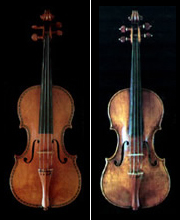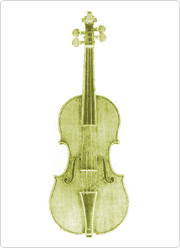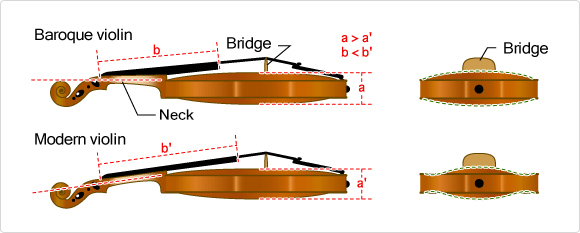The origins of the Violin
The development of the violin
The Mecca of the violin: Cremona
From the middle of the sixteenth century to the first half of the eighteenth century, the small town of Cremona in the Lombardia region of northern Italy was the center of violin production, and about 20,000 famous instruments were made there. Each of the families producing violins developed their own unique production techniques, which were passed on from generation to generation. The most famous of these were the five makers of the Amati family, the three makers of the Stradivari family, and the five makers of the Guarneri family. The violins of Carlo Bergonzi are also famous instruments.
These famous violins from Cremona are still much sought after today and are played by top violinists.

The family crest of a Cremona violin maker
Do violins reflect their makers?

Stradivari (left) and Guarneri (right)
Antonio Stradivari and Guarneri del Gesu were master violin makers in about the same period in Cremona, Italy. The two are revered as the finest violin makers in history, and their instruments are highly prized even today. However, the tonal qualities of their instruments are quite different.
Antonio Stradivari was born around 1644 and lived to a little past the age of 90, and he is said to have continued making violins until his final days. He created an estimated 1,100 instruments over the course of his life. Of these, roughly 600 violins, violas, cellos, mandolins, and guitars survive today. This is an incredible number of instruments for one person to make. Stradivari's instruments are known for the attention to detail in every aspect and their splendidly lustrous tone.
In contrast, Guarneri del Gesu lived from 1698 to 1744 and led a boisterous life. He drank a lot and is said to have spent some time in jail. It is estimated that he made about 300 violins, of which about 140 survive today. His violins are rough and wild, and have a deep, powerful tone.
What is the difference between Baroque and modern violins?
The violin was born essentially in its final form. Thus, there have been very few improvements made since.One improvement was made in the nineteenth century as a result of changes in musical fashions.
The fingerboard, for instance, was lengthened to reach the middle of the body. This was done to allow the players to play more of the high end of the E string. To increase the volume and brightness of the tone, the bridge was raised, along with the position of the fingerboard, to increase string tension.Older instruments to which these improvements have been made and new instruments modeled on these instruments are referred to as modern violins, while older violins that have kept their original form are referred to as baroque violins. Today, almost all Stradivari and Guarneri violins have been modified into modern violins.

A baroque violin

Comparative diagram of the baroque and modern
Musical Instrument Guide : Violin Contents
Origins
Structure
How to Play
How the Instrument is Made
Choosing an Instrument
Care and Maintenance
Trivia
- The f-hole used to be a C-hole or S-hole
- Why the f-hole?
- Violinists must bow to the horse
- Steel strings or gut strings? That is the question
- Is the chinrest the unsung hero of the violin?
- Most violin varnishes are also medicines
- Violin masterpieces: Solos I
- Violin masterpieces: Solos II
- Violin masterpieces: Solos III
- Violin masterpieces: Concertos I
- Violin masterpieces: Concertos II
- Viola masterpieces: Chamber music
- Viola masterpieces: Concertos
- Cello masterpieces: Concertos I
- Cello masterpieces: Concertos II
- Cello masterpieces: Solos
- Contrabass masterpieces: Concertos
- Contrabass masterpieces: Chamber music
- Orchestral masterpieces featuring the contrabass
- What do you call the part on the bow that you hold?
